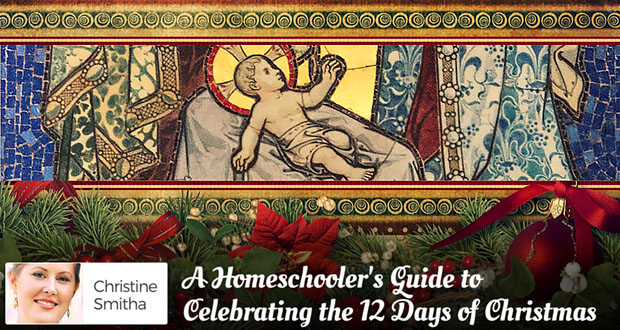If anyone in the Colorado Rockies had been awake during the wee hours of Christmas morning a couple decades ago, he might have heard the faint refrain, “Five golden rings, four calling birds, three French hens, two. . .”
That was the sound of our family wending our way back up the mountains after attending Midnight Mass in the city below. Though I occasionally wondered about the strange series of gifts, it never occurred to me to attempt dissecting the song, much less apply it as a rule of life for my Christmas holiday.
Fast forward a few years and a friend said, “You do know what that song is talking about, right? It’s the Catechism for persecuted Catholics!”
Well, as it turns out, there’s a bit of controversy about that, and the song is likely just a fun memory game that developed in 17th or 18th-century France.
Be that as it may, there is a recent convention of associating each of the numbered gifts in the carol with a particular element of the Catholic faith.
I like the idea of adopting the carol into family devotions, as Catholics have done with many local customs through the centuries. Perhaps a good way to celebrate the twelve days of Christmas would be to spend some time reflecting on these things, and discussing with your children the significance of each item on the appropriate day.
Young children especially will relish the opportunity to sing the song each day so they can find out what each number means.
The twelve days of Christmas also incorporate some of the calendar’s most noteworthy feast days, which provide ample opportunity for good works and devotions, an excellent way to continue celebrating Christmas.
Finally, it’s worth remembering that there is a foundation of innocence in most of the regular Christmas traditions and that there is no reason why Catholics can’t with purity of heart return to those innocent roots and enjoy these traditions with faith.
So give gifts with joy, but try giving one a day for each of the twelve days of Christmas. Think in terms of gifts the whole family can enjoy, such as a train set, a good movie about Christmas, or tickets to a Christmas program.
Enjoy the Christmas tree lights, but when you light them each night, gather the children for a prayer of thanks that Christ came to light the world.
Celebrate the year that has passed, but don’t forget to gain an indulgence from praying the Te Deum on December 31st.
Invite your parish priest over for a festive dinner, and have him bless your house with the traditional Epiphany blessing while you’re at it.
Welcome those who have no family to your “inn,” so they can enjoy Christmas too.
Let this Christmas renew your faith and inspire your family with gratitude for our True Love’s gifts!
A list of possible Catholic interpretations.
- A Partridge in a Pear Tree or Jesus Christ
- Two Turtledoves or the Old and New Testaments
- Three French Hens or Faith, Hope, and Charity
- Four Calling Birds or the Four Gospels
- Five Gold Rings or the first Five books of the Old Testament
The importance of these books, known as the Pentateuch, is that they tell of man’s fall into sin and his consequent need for a Savior, which is promised in Genesis, and fulfilled by the Nativity. - Six Geese or the Six Days of Creation
- Seven Swans or the Seven Gifts of the Holy Spirit (or the Seven Sacraments)
- Eight Maids or the Eight Beatitudes
- Nine Ladies or the Nine Fruits of the Holy Spirit
- Ten Lords or the Ten Commandments
- Eleven Pipers or the Eleven Faithful Apostles
- Twelve Drummers or the Twelve doctrines outlined in the Apostles’ Creed
Day 1: Dec. 25
The Nativity of Our Lord
This is a day for honoring the Baby Jesus. Even if you’ve gone to Midnight Mass, you can still keep Our Lord at the center of the day by gathering around the crèche for morning and nighttime prayers, preparing Jesus a birthday cake as do so many of Seton’s families, and singing religious carols, such as “Silent Night.”
Day 2: Dec. 26
St. Stephen, the first martyr
To honor the first martyr, who was also a deacon, and therefore particularly tasked with care of the poor, you might have everyone in the family search their possessions for items to donate to the poor via a St. Stephen’s box.
A pleasant side effect is that you won’t have as much trouble with the typical post-Christmas clutter. Read the stories of St. Stephen and St. Wenceslaus (who was also known for his almsgiving).
Day 3: Dec. 27
The Holy Family (2015; normally St. John the Evangelist)
In remembrance of the perfect and holy love that existed amongst the members of the Holy Family, do extra charitable works for one another, write thank you notes, and reach out to estranged or distant family members.
Day 4: Dec. 28
The Holy Innocents
This is a good day to offer prayers for an end to abortion, and also a day to pray for all those who are suffering persecution for their Catholic faith around the world.
At the same time, it is also the perfect day to celebrate the children in your family. Thank God for them and give them each a special blessing with holy water before bedtime on this feast day.
Day 5: Dec. 29
St. Thomas Becket, bishop and martyr
Read St. Thomas Becket’s Christmas Sermon from T. S. Eliot’s Murder in the Cathedral. It’s a sobering but worthwhile reflection on the broader meaning of Christmas and what it means to be a Christian in a pagan world.
Perhaps with your older children, you might pick an important issue about which to write your local and national representatives, urging them to vote wisely on matters of conscience.
Day 6: Dec. 30
6th day of Christmas
There is no particular feast assigned to December 30th, which means it’s an opportunity to return to the central mystery of Christmas, the birth of the Lord.
With the new year right around the corner, talk with your children about how they can do their part to bring the light of Christ to the world.
Day 7: Dec. 31
St. Sylvester I, Pope
This feast day of a pope reminds us to pray for our Holy Father and suggests that we commit to regular prayer for the pope and our bishops in the coming new year.
Day 8: Jan. 1
Holy Mother of God
There’s no better way to begin the new year than by honoring Our Blessed Lady! If you have a special icon or statue of our lady, put it in a place of honor in your home for the day, perhaps with flowers and candles.
Try praying the Rosary with your family after dinner this night, or if the kids are just too squirmy, sing some Marian hymns, such as “Salve Regina” and “O Sanctissima.”
Day 9: Jan. 2
St. Basil and St. Gregory Nazianzen
These saints were bishops and they are both Doctors of the Church. They also had a remarkable and abiding friendship with one another.
Read St. Gregory’s account of his friendship with St. Basil from Matins (the Office of Readings) for the feast day, and spend some time with good friends.
Talk to your children about the importance of friends in journeying to heaven, and help them put together cards with spiritual bouquets for their own friends.
Day 10: Jan. 3
The Holy Name of Jesus
Today is a day to reflect on the power of the Holy Name. On this day, one might consider making an Act of Reparation for those who have abused the Holy Name, and to meditate on the sacredness of all baptismal names.
Tell your children why you chose their names, and talk to them about speaking names with respect, as well as saying a prayer whenever they hear God’s name taken in vain.
Day 11: Jan. 4
St. Elizabeth Ann Seton
This day is a very special day for Seton families because it is the feast day of our patron, Mother Seton.
Today might be a good day to freshen up the schoolroom or school corner. It’s also an appropriate day for getting together with homeschooling friends, perhaps for a potluck dinner at which St. Elizabeth is honored with skits from the children about her life.
Day 12: Jan. 5
St. John Neumann
The 4th bishop of Philadelphia, St. John Neumann was also an important proponent of Catholic education in the United States.
Along with the previous day’s feast, this is a good day to celebrate Christmas with fellow homeschoolers.

 Seton Magazine Catholic Homeschool Articles, Advice & Resources
Seton Magazine Catholic Homeschool Articles, Advice & Resources

